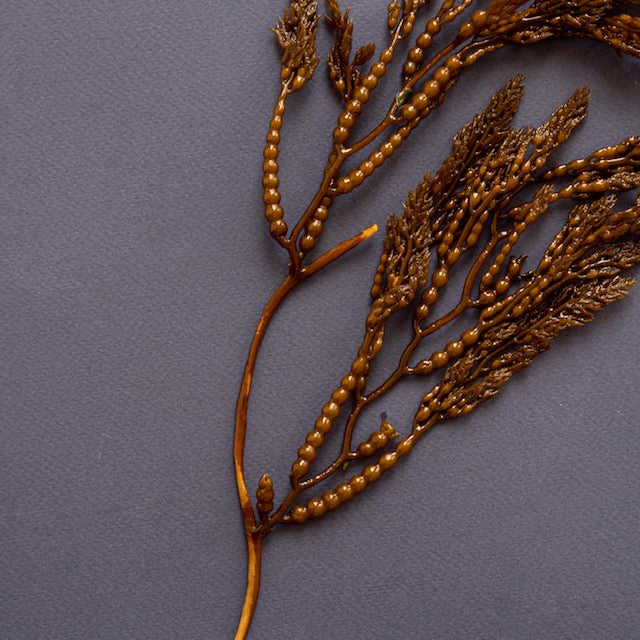
Each year I eagerly await the coastal call to gather seaweed along the rugged northern California shoreline. The timing is everything. The rocks are exposed, and long strands of seaweed sway in the shallows like ribbons. At dawn, the moon pulls the waters low and reveals a hidden, wild garden beneath.
This blog is a love letter to that ritual. Part field guide, part recipe collection, part invitation to slow down and meet the day with wonder. Whether you're new to wildcrafting or already have your own tide-watching rituals, I hope this serves as a helpful ally. The magick of seaweed harvesting lies in how it roots you to place and season.
After you spend the morning at the tide pools, may I suggest a seaside feast? Be sure to pack a pot of sushi rice and a jar of soy sauce. After rinsing your seaweed harvest, cut it into small ribbons and let it steep in the soy for about ten minutes. Spoon the marinated seaweed over the rice, then finish with a drizzle of sesame oil, a dash of sriracha, slices of ripe avocado, and a squeeze of fresh lemon. The result is briny, bright, and deeply satisfying.
What to Pack
- Backpack
- Field guide
- Shoes that can get wet
- Heavy duty plastic bags with handles. I found this to be the easiest way to hold wet and sometimes heavy seaweed while scaling jagged rock. Poke a few VERY small holes at the bottom allow water drainage.
- Gloves
- Clippers/knife
- Small colander (collapsible is convenient)
- Jacket/sunscreen (you just never know)
- Lunch/utensils
Seaweeds and Uses
Bladderwrack
A moon-ruled seaweed, rich in iodine, this brown beauty supports the thyroid and metabolism. Harvest during its fertile phase when its tips swell with mucilage. Dry it for teas or healing baths, or use fresh for sprains, bruises, and soothing salves. This one belongs in every sea witch’s apothecary.
Bulb Kelp
Rich in salts, potassium chloride, protein, calcium, iron, and zinc, bulb kelp offers a plethora of nutrients. This kelp can be sliced and pickled for earthy, oceanic bites. Always harvest above the bulb to ensure renewal.
Sea Condom
Hollow sacs clinging to low tide rocks, these odd little pouches are edible and fun. Try stuffing them with grains or gently marinating. Harvest young and respectfully.
Feather Boa
A long, gelatinous strip of seaweed awaits, ranging in color from dark brown to olive green and stretching up to 11 feet in length. This seaweed is perfect for incorporating into your bathing rituals, as it can be wrapped around your body and used to wash your back. When harvesting, focus on gathering the tender young parts of the plant to ensure optimal quality. Once cooked, this seaweed becomes delightfully tender, and adding the floats to soups can bring an element of fun to your culinary endeavors.
Cystoseira
One of my personal favorites. This delightful seaweed is a treat when pickled straight from the sea. It can be found in the low to sub intertidal zones, often in deeper waters. With the potential to grow up to 15 feet in length, it's truly impressive. To harvest, simply snip the tips.
Nori
Delicate and dark, this protein-packed seaweed is beloved in kitchens and covens alike. To harvest, gently pull it from the rocks and give it a thorough rinse in sea water. Afterward, dry it well in the sun or lightly toast it in the oven or a cast iron pan. Crumble over soups, grains, or into a salty snack blend. These flakes are a true delicacy, boasting high iron and protein content, as well as an abundance of minerals and vitamins.
Turkish Towel
With a textured surface and colors ranging from red to brown, this remarkable seaweed can be used just like a washcloth. When handled, it releases healing gels that are beneficial for the skin. Its unique texture makes a natural exfoliant for ritual bathing and skincare.
Sea Lettuce
Bright green and full of life, this upper-zone seaweed is light, tasty, and rich in nutrients. Make sure to thoroughly rinse it in sea water using a colander to remove any sand or shellfish that may be clinging to it. Use fresh or dry it for a sprinkle of ocean in every dish.
Kombu
A deep-diving, mineral-rich kelp that helps soften beans, thicken broths, and draw heavy metals from the body. When harvesting, trim each blade about 2 to 3 inches above the stipe, ensuring that you leave enough for the native kombu to continue growing. This careful approach helps sustain its growth. Its presence is grounding, nutritive, and purifying, perfect for soup or spell.
Dulse
Deep red and rich with flavor, dulse makes an incredible savory seasoning. Use as a mineral salt substitute or crumble into dishes for depth and nourishment. Harvest by pulling the longer blades from the rocks, leaving the shorter blades for regeneration. Spread out on screens to dry as quickly as possible. You will need the whole day to dry, so if you harvested at midday, hold the crop overnight and spread it out to dry in the morning.
Wakame
A lower-zone seaweed, brown to olive in color, tender and versatile. Harvest with a knife or scissors to cut off the end of the blade, leaving at least three feet above the sporophylls to ensure successful reproduction.
Sea Palm
These enchanted mini-palm trees are rare and endangered. If you harvest, do so lightly and gratefully. They firmly attach themselves to the outer surface of the rocks. To harvest sea palm, carefully use scissors to cut the leafy fronds from the main body (thallus), leaving the stalk (stipe) intact. These seaweed strands, often referred to as sea noodles, are exclusive to the Pacific Northwest region.
Foraging Tips
Always rinse your seaweed with sea water right after harvesting. Avoid collecting near polluted areas or from washed-up beach wrack. Learn to identify acid kelp, a toxic impostor that turns other seaweeds ghost-white. Never harvest more than you need. Let respect and reciprocity guide you.
As always, I recommend connecting with a skilled herbalist or seaweed forager before you begin. A field guide can become your grimoire of the tides, and local Facebook groups often share tips, tides, and treasures from the sea.
Seaweed Recipes
Pickled Seaweed
A coastal kitchen staple. Start with a mason jar and a handful of freshly harvested, salt-rinsed seaweed. Cystoseira works beautifully. Fill the jar with equal parts apple cider vinegar, soy sauce or tamari, and rice vinegar. Add two tablespoons of sesame oil, a generous pinch of red pepper flakes, and finely chopped garlic, onion, and ginger. Let it marinate and mingle. The result is tangy, briny, and full of ocean magick.
This recipe is pure alchemy. Sweet, salty, mineral-rich, and delightfully crunchy.
Dry and lightly toast nori or any edible seaweed in a hot cast iron skillet for about a minute, just until it darkens and crisps. Watch closely to avoid burning. In the same pan, toast a mix of seeds and nuts such as sunflower, sesame, flax, pumpkin, almonds, cashews, or walnuts.
Grind half of the seaweed and nut mixture in a food processor until crumbly. In a large bowl, combine with the rest of the seeds and just enough brown rice syrup to bind it all together. You can also add candied ginger or chopped dried fruit if you like. Press the mixture onto a baking sheet lined with parchment, cover with plastic wrap, and use a rolling pin or your body weight to flatten it into a dense, even sheet. For extra indulgence, melt chocolate chips and spread across the top before chilling in the fridge for about an hour. Slice into bars and enjoy.
More Seaweed Magick
Seaweed is endlessly versatile. Try drying and powdering your harvest to mix into salt blends or sprinkle into smoothies. It also makes a lovely DIY face mask. Combine powdered seaweed with honey or yogurt and smooth it onto clean skin. Let it rest, rinse gently, and feel the minerals soak in.
Wisdom and Caution
As always, move with care and respect when harvesting from the ocean. Keep a close eye on the tides and make sure you have a safe path back to shore. Do not enter the intertidal zone unless you are confident in your ability to swim.
Seaweed can absorb heavy metals such as lead, cadmium, and copper. It is best to avoid harvesting near densely populated areas or industrial zones. Be cautious of seaweed washed up on shore, as it may be decaying. Learn to identify Acid Kelp, a rare and toxic plant that turns other seaweeds white and breaks them down.
Harvest thoughtfully. Use your intuition.
Love and Magick -Colleen
Dandelion Herbal Center Class Notes 2012 taught by Jane Bothwell
Sea Vegetables: A Harvesting Guide and Cookbook by Evelyn McCoonaughey
Sea Vegetables Gourmet Cookbook and Wildcrafters Guide by Eleanor and John LeWallen https://seaweed.net/
Mendocino Sea Vegetables https://seaweedmermaid.com/




Comment
Great recipes & descriptions. Thank you!